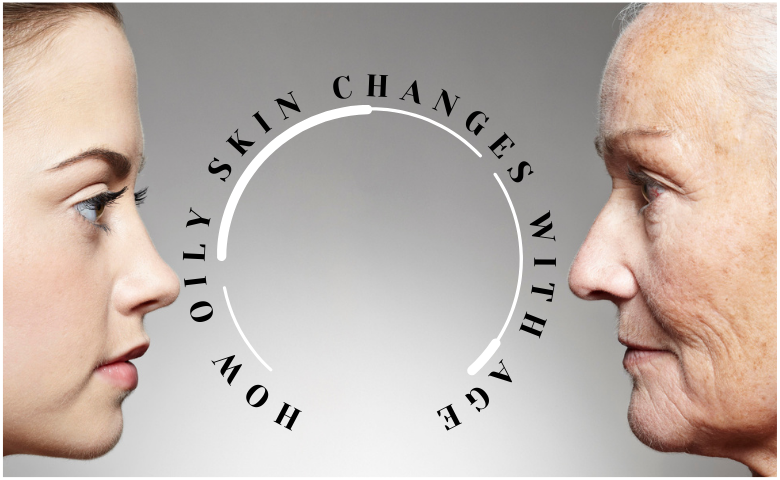
Table of Contents
The glands that produce sebaceous tissue are responsible for producing an excess of sebum, which causes oily skin. This disorder can cause problems for people at any stage of their lives. Although oily skin is typically associated with childhood and adolescence, its traits and implications change as people age. Individuals can alter their skincare routines and efficiently maintain their skin health by being aware of the changes that occur in oily skin as they age. In this post, we will look at how oily skin develops during life and offer some advice on how to manage these changes effectively.
Teenage years and the start of adulthood
How oily skin changes with ages?Hormonal changes are the primary cause of oily skin during adolescence. When a person hits puberty, their androgen levels rise, which stimulates their sebaceous glands to generate more sebum. The presence of so much oil is usually the underlying cause of common skin problems including acne and a shiny appearance. Adolescents with oily skin are more likely to have acne breakouts, blackheads, and enlarged pores.
At this point, it is critical to follow a best skincare routine that successfully limits oil production while also providing the skin with the required hydration. Gentle, non-comedogenic exfoliator and cleansers can help to prevent acne and reduce excess oil production on the skin. Additionally, oil-free sunscreens and moisturisers are beneficial for preserving the skin’s hydration levels without making it oilier.
Throughout the 1920s and early 1930s
Hormonal changes can still affect a person’s sebum production as they enter their twenties and early thirties; however, these effects normally level out in comparison to those seen during adolescence. As hormone levels remain consistent throughout this time, the skin’s oiliness may progressively decrease. Despite this, lifestyle factors such as stress, nutrition, and environmental exposure can all have an impact on sebum production and overall skin health.
Even after reducing the quantity of excess oil on their skin, persons in their twenties and thirties may continue to encounter concerns such as recurring acne or early symptoms of ageing. It is critical to combine skincare products that address new difficulties, like as fine lines and uneven texture, with therapies that control oil and prevent breakouts. Acne and early indications of ageing are both curable disorders that can be managed with the use of drugs containing chemicals like retinoids.
Middle years
The natural process of ageing causes the skin to undergo a more dramatic transition during the thirties and forties. The production of sebum decreases, making the skin’s oil glands less active. Those who were used to having oily skin may notice a dryness of the complexion as a result of the reduction in oil production.
As a result of this decrease in oil, people may notice changes in their skin, such as increased dryness, flakiness, or tightness. As a result, regular skincare regimes must be changed to meet the skin’s constantly changing needs. Richer moisturisers, moisturizing serums, and products containing hyaluronic acid or ceramides are more crucial than ever for preventing dryness and maintaining skin moisture levels.
In the 1950s and Ahead
Sebum production continues to diminish throughout the 1950s and beyond, resulting in noticeably dry skin. One of the most crucial components of this transition is hormonal volatility, specifically the drop in oestrogen levels that occurs after menopause. The skin’s natural oil barrier may become less efficient, resulting in more visible age spots, small wrinkles, and a decrease in the skin’s capacity to retain moisture.
Currently, the fundamental goals of skincare products must be the restoration of the skin barrier and rigorous hydration of the skin. A range of chemicals are used in treatments to help relieve dryness and increase skin suppleness. These compounds include antioxidants, heavier emollients, and peptides. The constant use of gentle exfoliants that do not irritate the skin can help to maintain its texture and promote cell turnover.
Other Factors That Affect Our Oiliness as We Grow Older
The following external variables may influence oily skin’s ageing process:
The nutrition and lifestyle decisions that a person makes during their life have a substantial impact on the overall health of their skin. Diets heavy in sugar and processed meals may worsen oiliness and acne. On the other hand, necessary diet rich in vitamins, antioxidants, and omega-3 fatty acids is helpful to the skin in general and supports healthy skin. To maintain skin balance, decrease stress and consume plenty of water.
Exposure in extreme weather
Pollution, sun exposure, and, in particular, extreme seasonal changes can all have an effect on sebum production and skin texture. People of all ages should wear sunscreen to protect their skin from ultraviolet (UV) radiation, which may worsen the indications of aging and interfere with oil production.
Several drugs, including hormone therapy, have the potential to alter sebum production. It is critical to check with medical professionals about the potential detrimental effects of drugs on skin health and adapt skin care practices accordingly.
In conclusion,
The progression of oily skin from adolescence to old age demonstrates the dynamic nature of skin health and the considerable effect that aging has on sebum production. Despite the fact that oily skin is generally associated with youth, it typically declines with age, resulting in drier skin and the need for a more moisturising skincare routine. Individuals who are aware of these changes can adjust their skincare regimes to meet the changing needs of their skin, ensuring that they retain the right level of skin health and attractiveness for the rest of their lives.
